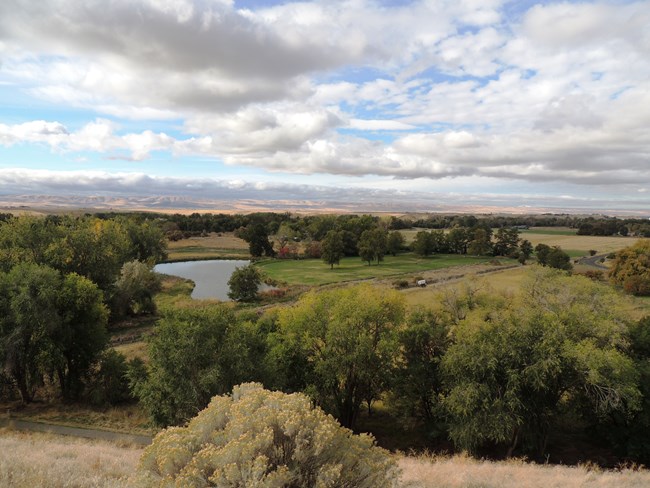Part of a series of articles titled Women's History in the Pacific West - Columbia-Pacific Northwest Collection.
Article
Maria Keawea Maki

NPS Photo by Kate Kunkel Patterson.
Maria Keawea Maki was among the Native Hawaiians who participated in nineteenth-century Anglo-led missionary efforts in Oregon Territory.1 Maki and her husband Joseph were affiliated with the American Board of Commissioners for Foreign Missions (ABCFM) through the Kawaiaha‘o Church in Honolulu. Between 1838 and 1841, they labored on behalf of the mission that Marcus and Narcissa Whitman established near Fort Walla Walla in their unsuccessful efforts to convert the Cayuse to Christianity.2 Maria and Joseph Maki’s presence at the Whitman Mission is evidence of the international reaches of Presbyterian missionary activity, as well as the key role of Indigenous converts in such transnational missionary endeavors.
Founded in 1810 in Massachusetts, ABCFM was the first American foreign mission organization. It sent missionaries throughout the globe to convert Indigenous populations. The ABCFM established a mission in Honolulu in 1820.3 The Hawaiian church claimed 5,000 converts by 1837 when members began assisting the Oregon Mission of the ABCFM.4 Seeking laborers to help run their farm, Marcus and Narcissa Whitman requested the ABCFM assign Hawaiian couples to their mission.5
The Makis’ physical labor was central to the development of the Whitman mission. The Makis arrived at the Whitman Mission in June 1838.6 There, Maria Maki worked as a cook while Joseph laid floors and practiced carpentry. They also tended the sheep that they brought with them from Hawai‘i. Narcissa Whitman’s letters indicate how reliant she became on Maki for support, saying she was “so faithful…I know not how I could do without her.”7
The Whitmans’ belief in racial hierarchy informed their view that the Makis provided a model of Indigenous conversion to Native Americans, whom the Whitmans, like most Euro-Americans referred to as “savages.”8 Marcus Whitman described the Makis as “very useful to us & their example good among the Indians.”9 When after refusing to learn a single Native language, the Whitmans failed to convert the Cayuse, the missionary couple directed their religious uplift lessons toward Native Hawaiian laborers at the mission like the Makis, viewing such work among Indigenous Hawaiians who had already converted to Christianity as surrogates for their goals.10
The Whitmans’ embrace of race hierarchy also informed their professed admiration of the Makis’ religious devotion.11 Maki and her husband were charter members of the First Presbyterian Church in Oregon Territory that the Whitmans organized in August 1838, a church with global origins crafted from ABCFM networks.12 Joseph Maki died in August 1840 from an inflammation of the bowels, and Narcissa Whitman exclaimed “our loss is very great.”13 Maria Maki stayed with the Whitmans for another year, and left in the fall of 1841. Maki traveled to Honolulu in the company of another missionary couple departing Oregon Territory.14 Because of their lack of success with Native conversions, the Whitmans redefined their missionary work to help bring more Anglo-American settlers to the region and continue to establish religious institutions.15 There are no known records on Maki following her arrival back in Honolulu, but one can imagine she relied on her church community and continued her religious service in Kawaiaha‘o Church. Her life reflects the disruption that accompanied missionary activities in the Pacific and the initiative taken by some Native Hawaiian women converts in response to those changes.
Further Reading:
- Barman, Jean, and Bruce McIntyre Watson, Leaving Paradise: Indigenous Hawaiians in the Pacific Northwest, 1787–1898. Honolulu: University of Hawai‘i Press, 2006.
- “Pineapples and Rye Grass: The Role of Hawaiian Laborers at Whitman Mission,” https://www.nps.gov/whmi/learn/historyculture/hawaiian-laborers-at-whitman-mission.htm.
1 - Jean Barman and Bruce McIntyre Watson, Leaving Paradise: Indigenous Hawaiians in the Pacific Northwest, 1787–1898 (Honolulu: University of Hawai‘i Press, 2006), 131.
2 - “Pineapples and Rye Grass: The Role of Hawaiian Laborers at Whitman Mission,” accessed Sep 4, 2020, https://www.nps.gov/whmi/learn/historyculture/hawaiian-laborers-at-whitman-mission.htm.
3 - “Kawaiaho‘o Church and Mission Houses,” National Park Service, accessed Aug. 27, 2020, https://www.nps.gov/places/kawaiaha-o-church-and-mission-houses.htm.
4 - Clifford M. Drury, Marcus and Narcissa Whitman and the Opening of Old Oregon, volumel 1 (Glendale, California: The Arthur H. Clark Company, 1973), 259.
5 - Barman and Watson, Leaving Paradise, 117.
6 - Drury, Marcus and Narcissa Whitman, 260; Barman and Watson, Leaving Paradise, 117.
7 - Narcissa Whitman to her mother, October 9, 1840, reproduced in Transactions of the Twenty-First Annual Reunion of the Oregon Pioneer Association for 1893 (Portland, Oregon: Geo. H. Himes and Company, Printers, 1894), 135.
8 - Barman and Watson, Leaving Paradise, 120–121, 131; Julie Roy Jeffrey, Converting the West: A Biography of Narcissa Whitman (Norman: University of Oklahoma Press, 1991), 107–108; Ann Hyde, Empires, Nations, and Families: A New History of the North American West (New York: HarperCollins, 2011), 404.
9 - Marcus Whitman, as quoted in Barman and Watson, Leaving Paradise, 117.
10 - Hyde, Empires, Nations, and Families, 404; Barman and Watson, Leaving Paradise, 117.
11 - Drury, Marcus and Narcissa Whitman, 271; Barman and Watson, Leaving Paradise, 117.
12 - Drury, Marcus and Narcissa Whitman, 307; Kate McBeth Journal, accessed Aug 27, 2020, https://www.lib.uidaho.edu/mcbeth/journal/missionhx.htm, for more information, see https://www.lib.uidaho.edu/mcbeth/katepaper.htm.
13 - Narcissa Whitman to her mother, Oct 9, 1840.
14 - Barman and Watson, Leaving Paradise, 123.
15 - Lorena Oropeza, “Women, Gender, Migration, and Modern US Imperialism,” in Ellen Hartigan-O’Connor and Lisa G. Materson, eds., The Oxford Handbook of American Women’s and Gender History (New York: Oxford University Press, 2018), 91.
Acknowledgements:
This project was made possible in part by a grant from the National Park Foundation.This project was conducted in Partnership with the University of California Davis History Department through the Californian Cooperative Ecosystem Studies Unit, CA# P20AC00946
Last updated: February 22, 2022
